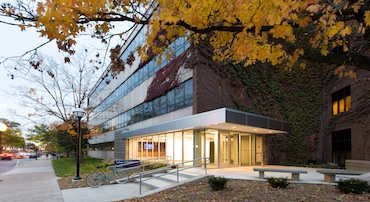Collaboration Rules Modern Research Enterprise

Steven P. Schwendeman, PhD, remembers when his father, also an academic, was coming up through the ranks.
“Back then, it was important to show how independent you were so there was a disincentive for some scientists to seek out potential collaborators,” says the Ara G. Paul Professor and Chair of Department of Pharmaceutical Sciences.
Luckily, that approach was already slipping into history when Schwendeman was a U-M College of Pharmacy graduate student in the late 1980s and early 1990s. You might say he cut his academic teeth on collaboration.
“My two thesis advisors at U-M had a scientific partnership,” he recalls. “I spent about half my time in each lab: one focused on clinical application; the other on fundamental science.”
Dr. Schwendeman then did a post-doc at MIT where he again stepped into a ready-made collaboration: this one between an academic lab at MIT and the Massachusetts lab that made vaccines for the state.”
That collaborative model persisted through numerous research projects after he became a faculty member, first at Ohio State and, since 2000, at the U-M. Most recently, Schwendeman’s credentials as a collaborator played an important part in the U.S. Food and Drug Administration’s (FDA) decision to make him a key player in the $4.8 million funding package awarded to the College this fall.
“Current research requires expertise in a number of areas outside a single principal investigator’s discipline,” Dr. Schwendeman notes. “Our success with the FDA, and other funding agencies, is a by-product of our commitment to collaborative research.”
But while collaborative expertise is crucial to gaining grants, collaboration is at its best when the team is made up of outstanding individual talent. “Each collaborator has to bring some special strength to the table,” Dr. Schwendeman says. “When good scientists join forces, the level of innovation and creativity increases exponentially.”
This is especially true in biomedical research where there are so many different aspects of the problem.
The Department of Pharmaceutical Sciences recognized the importance of collaboration when it incorporated that qualifier as a priority in its recently developed strategic plan. That said, Dr. Schwendeman warns against over-simplification.
“Creating the right collaboration and maintaining it is not a trivial concern,” Dr. Schwendeman states. “There are a lot of personalities involved and professional agendas that may not be apparent at the outset. I’ve been a part of a number of collaborations. Some have been very positive and some haven’t. It’s about understanding what’s necessary and choosing the right people.”
Since much of the work for this grant entails in vivo research, Dr. Schwendeman is hopeful that the College can parlay this into future FDA funding. As competition for research dollars becomes increasingly fierce, every competitive edge is precious.
“This is one of the largest in vivo projects that has ever been funded in our lab,” Dr. Schwendeman emphasizes. “The techniques we develop will help us compete for future support from the FDA, and from other sources.”



